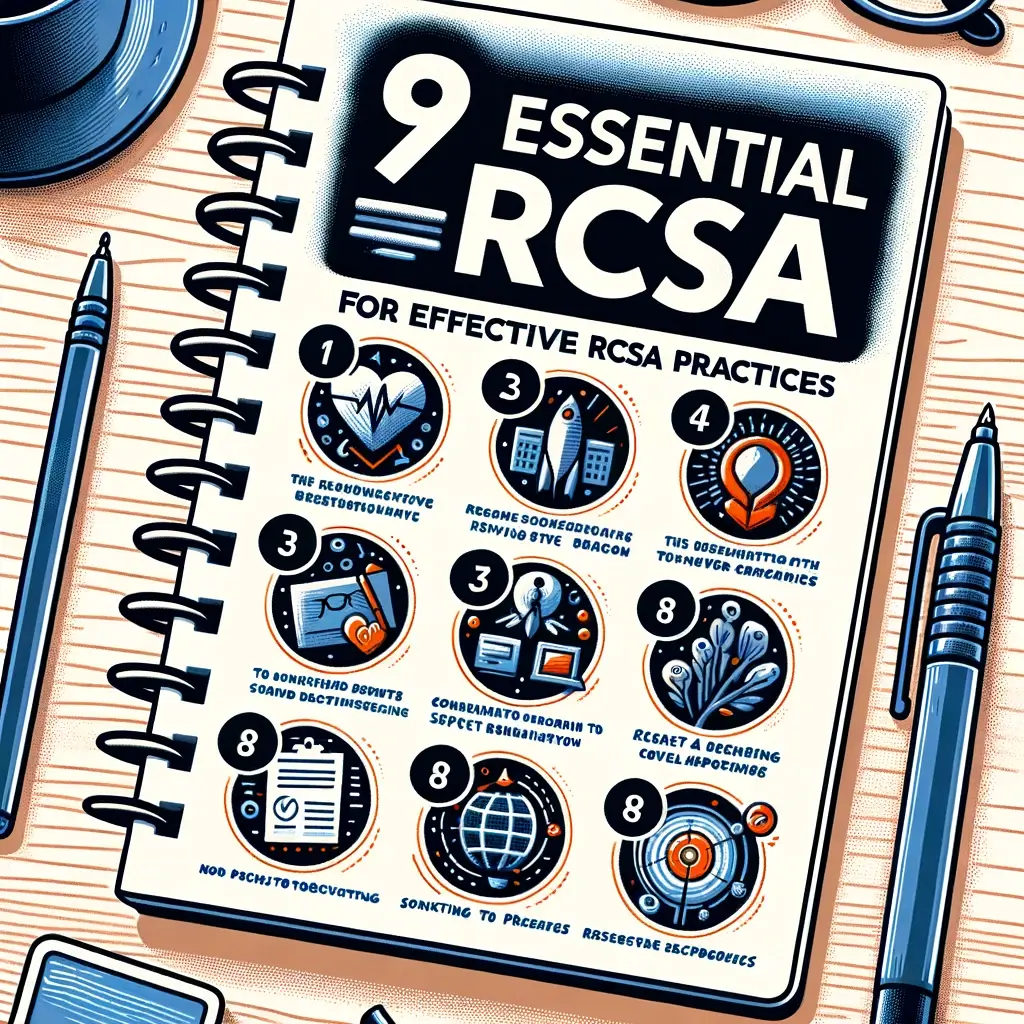In the ever-evolving business world, mastering the discipline of risk and control self-assessment (RCSA) remains key to fostering resilience, efficiency, and, above all, harnessing potential growth. They include:-
- Develop a comprehensive risk taxonomy (source: The Global Treasurer)
- Use a consistent rating methodology (source: The Global Treasurer)
- Ensure that the RCSA process is transparent and well-communicated (source: The Global Treasurer)
- Establish clear roles and responsibilities (source: The Global Treasurer)
- Leverage technology to streamline the RCSA process (source: MetricStream)
- Foster a culture of risk awareness and accountability (source: AITechTrend)
- Encourage open communication and collaboration across departments (source: AITechTrend)
- Use scenarios to supplement the RCSA process (source: Bank for International Settlements)
- Ensure that the RCSA process is reviewed and updated regularly (source: The Global Treasurer)
From understanding and adapting to the complex and constantly changing regulatory environment to inculcating a holistic culture of risk awareness, the depth of expertise necessary is both intensively challenging and immensely rewarding.
At the foundation of these efforts lies the indispensability and potent power of effective RCSA practices, serving as an armour and compass for businesses aiming to navigate the often treacherous waters of their respective industries.
This piece elucidates nine crucial practices that every professional must adopt to leverage the benefits of RCSA truly, thus effectively staving off risks while capitalizing on emerging opportunities.
Mastering Regulatory Environment
Navigating the intricate network of regulations in the world of business can seem like a daunting task, but fear not! A deep understanding of the regulatory environment and how it impacts your business will not only protect you in the face of penalties or lawsuits but also offer a competitive advantage that could fuel the success of your company.
This crucial knowledge lends insight into the marketplace; it’s like having an entrepreneurial GPS. An intimate understanding of regulatory components, such as licensing, zoning, and industry-specific requirements, will guide your business growth strategy, prevent regulatory surprises, and help you seize opportunities others may overlook.
Privacy laws are no less significant on your regulatory checklist. With the advancement of technology, businesses now handle significant amounts of data, both for their operation and of their customers.
The repercussions of mishandling such data are severe, both in terms of penalties and consumer trust. A savvy entrepreneur ensures the implementation of robust and adaptable processes that not only respect global data protection laws but also safeguard the business’s credibility.
Environmental regulations, too, carry tremendous business implications. Eco-conscious consumers increasingly favor businesses with a low environmental footprint, a trend that can be leveraged for competitive advantage
Businesses that proactively comply with, or better yet exceed, environmental regulations present themselves as industry leaders and pioneers.
Labor and employment laws may differ by geography and scaling stage, affecting many business areas. More than mere compliance, it impacts your culture, employee satisfaction, and your reputation as an employer.
In an era where skilled employees are often more challenging to secure than capital, regulatory competence can create a defining edge.
Taxes! Of course, taxes. While perhaps not the most liked topic among entrepreneurs, a sound understanding of tax laws and policies, their nuances, and their exceptions can make a significant impact on your bottom line. Why leave money on the table when the same law offers you a way to maximize returns?
Lastly, but no less critical, are industry-specific regulations. From the heavily regulated pharmaceutical and banking industries to the hardly regulated software industry, these rules can both limit and afford opportunities.
Eyeing that global expansion? Don’t ignore the regulatory differences between countries or regions, or it can be a costly miss.
Having an in-depth knowledge of the regulatory environment for your business is a necessity, not an option. It equips entrepreneurs with the ability to strategize efficiently, avoid pitfalls, and structure their businesses for a landscape of success. So, roll up those sleeves and get regulatory savvy!

Prioritizing & Ranking Risks
Risks, by their very nature, are a daunting aspect of business and entrepreneurship. Nevertheless, their potential impact on crucial aspects such as revenue, market share, industry reputation, and overall viability cannot be underestimated, making them an essential consideration in any business decision.
Quite unequivocally, not all risks carry equal weight and potential consequences, and the ability to efficiently rank them can significantly contribute to a business’s ability to survive and thrive in today’s ever-evolving markets.
Knowing how to prioritize risks begins with understanding that not all risks are equal. Some are common across all businesses, such as financial risks.
In contrast, others are unique to certain industries, such as technological obsolescence in the tech industry or weather-related risks in agriculture.
It’s essential to understand the difference between systematic and unSystematic risks. Systematic risks, such as market or interest rate fluctuations, affect multiple industries and can’t be eliminated by diversification.
Unsystematic risks, conversely, are specific to a particular firm or industry and can be mitigated or eliminated through diversification.
Information plays a crucial role in ranking business risks. Continuous research of industry trends, customer behavior, and regulation changes can provide valuable insights into potential risk factors and their possible impact.
For instance, a demographic shift in customer behaviour can signal potential risks to market share. Likewise, pending changes in taxation or environmental regulations can create future financial or operational risks.
Savvy entrepreneurs can utilize a quantitative risk assessment, transforming qualitative risk elements into a numerical value for easier comparison, prioritizing, and decision-making.
Some businesses adopt a risk matrix, scoring each risk factor based on its likely impact and likelihood of occurrence.
Lastly, entrepreneurs need to be aware of “black swan” events – unpredictable incidents beyond what is usually expected and potentially bring severe consequences.
COVID-19, for example, was a black swan event that dramatically affected the global economy and many industries. It’s tricky to plan for such events, but having a flexible, adaptable strategy can make a difference.
So, to wrap up, are all risks equal? Certainly not. And is ranking them efficiently critical? Absolutely. Creating a system that recognizes, evaluates, and prioritizes risks is one of the best strategies an entrepreneur can use.
It gives businesses the resilience to handle threats, take calculated risks, innovate, grow, and lead in their respective markets.

Creating a Culture of Risk Awareness
To successfully navigate the business world’s ever-changing landscape, fostering a risk-aware culture within your organization is an imperative move. But what steps can be taken to further solidify this culture? Let’s delve into some critical avenues of exploration.
Firstly, establish a robust risk management process. This process should ideally not only identify but also assess and mitigate potential business threats.
A standard risk management process involves risk identification, risk evaluation, development of risk control measures, and their implementation and maintenance. The approach should be periodically updated to reflect the latest threat landscape.
Integrate risk management into decision-making. With political and economic uncertainties in flux, every decision carries potential implications and risks. By integrating risk management into decision-making, organizations can make informed choices for expected outcomes, evaluating risks against performance expectations.
Adapt and align risk management with your business strategy. It’s essential to formulate tactical measures to counter possible risks in tandem with your growth strategy.
Risk management and business strategy should go hand-in-hand; only then can effective risk mitigation and business growth be achieved simultaneously.
Next, engage employees in risk management discussions. Every team member should understand how risk management affects their daily responsibilities and overall organisational role.
Incorporating risk awareness into your organization’s ethos can manifest in numerous ways, including risk management training, employee accountability, and rewards for risk-mitigating behavior.
Finally, harness technology for risk management. Technology is a powerful tool that organizations can employ to stay ahead of potential risks.
Cybersecurity measures, risk assessment software, compliance solutions, and predictive analytics contribute to a more sophisticated risk management framework, bolstering an organization’s defenses.
Risk awareness and mitigation are necessary for any organization to grow, evolve, and thrive. With these stepping stones, it’s possible to foster a proactive, risk-aware culture that supports your business’s successful journey into the future.

Understanding the regulatory landscape and creating a culture of risk awareness are vital paradigms, but effective RCSAs cannot ignore the crucial component of prioritizing and ranking risks.
By getting to grips with the nuances of potential risks, their potential damage, and their probability of occurrence, organizations can create targeted control measures.
This risk-based approach is not about eliminating all risks but understanding them deeply to employ strategic management. The intelligent application of RCSA practices is vital for navigating today’s uncertain environment; it is the requisite tool for those aiming at a prosperous future.
As we continuously adapt to the shifting sands of our industries, stay ahead by embracing risk, understanding it, and using it as a tool for growth and success.

Chris Ekai is a Risk Management expert with over 10 years of experience in the field. He has a Master’s(MSc) degree in Risk Management from University of Portsmouth and is a CPA and Finance professional. He currently works as a Content Manager at Risk Publishing, writing about Enterprise Risk Management, Business Continuity Management and Project Management.

